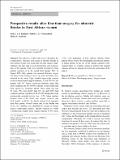Prospective Results after First-time Surgery for Obstetric Fistulas in East African Women
Publication Date
4/20/2007Type
Article, Journalviews
downloads
Metadata
Show full item recordCitation
Int Urogynecol J DOI 10.1007/s00192-007-0389-6
Abstract/
The objective of this study was to document the complications, outcomes and causes of obstetric fistulas in East African women who underwent first-time surgical repair. Attention was also paid to social background and characteristics of the patients. Data were collected prospectively from patients operated on in the period from January 2001 to August 2003. Only patients who received first-time surgery and whose fistula had been caused by obstructed labour were included in the study. Eight hundred eighty-eight patients received fistula-related surgical treatment. A total of 639 of the patients with 647 fistulas underwent first-time repair. Our study comprised the 581 (90.9%) patients whose fistulas had been caused by obstructed labour. Their mean age was 27 years, 70% were shorter than 156 cm, and 30.8% had completed primary education. In 45.1%, the fistula patient was primigravida; perinatal survival was 11.5%. Mean duration between onset of the fistula and surgical treatment was 36.4 months. In 40.6%, the fistula patients lived separated from their partner. Overall closure rate of the fistulas was 93.8%. No variables were identified for success of closure using a multivariate analysis. Patients operated on within 3 months had a slightly better surgical outcome 93.9% versus 87.0%. Our population of East African obstetric fistula patients shared most of the demographic and physical features of fistula patients in the rest of the African continent. Early surgical repair (<3 months) seemed to improve the surgical outcome and can be expected to restore the social status of the patient.
Publisher
SpringerCollections
- General - GEN [367]

